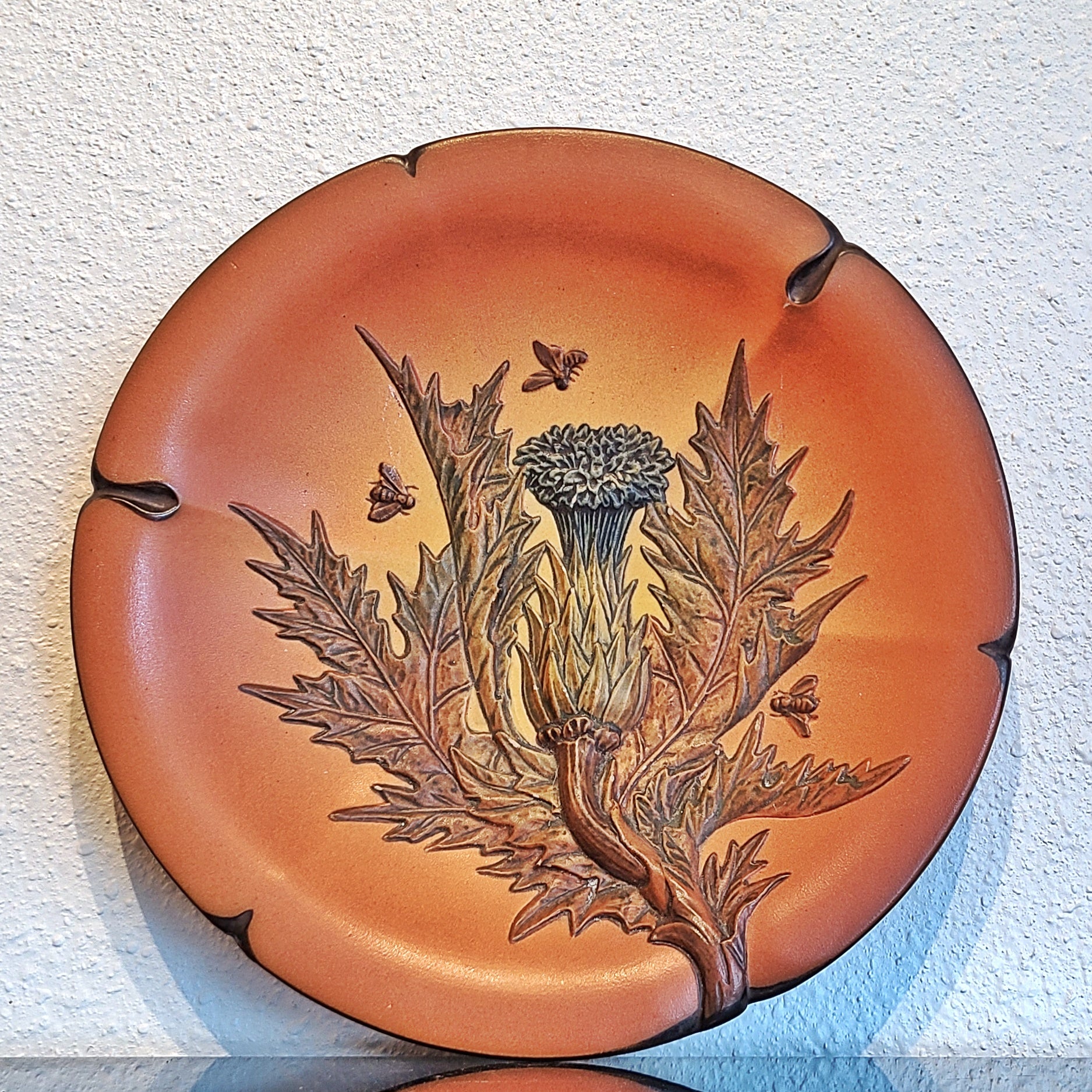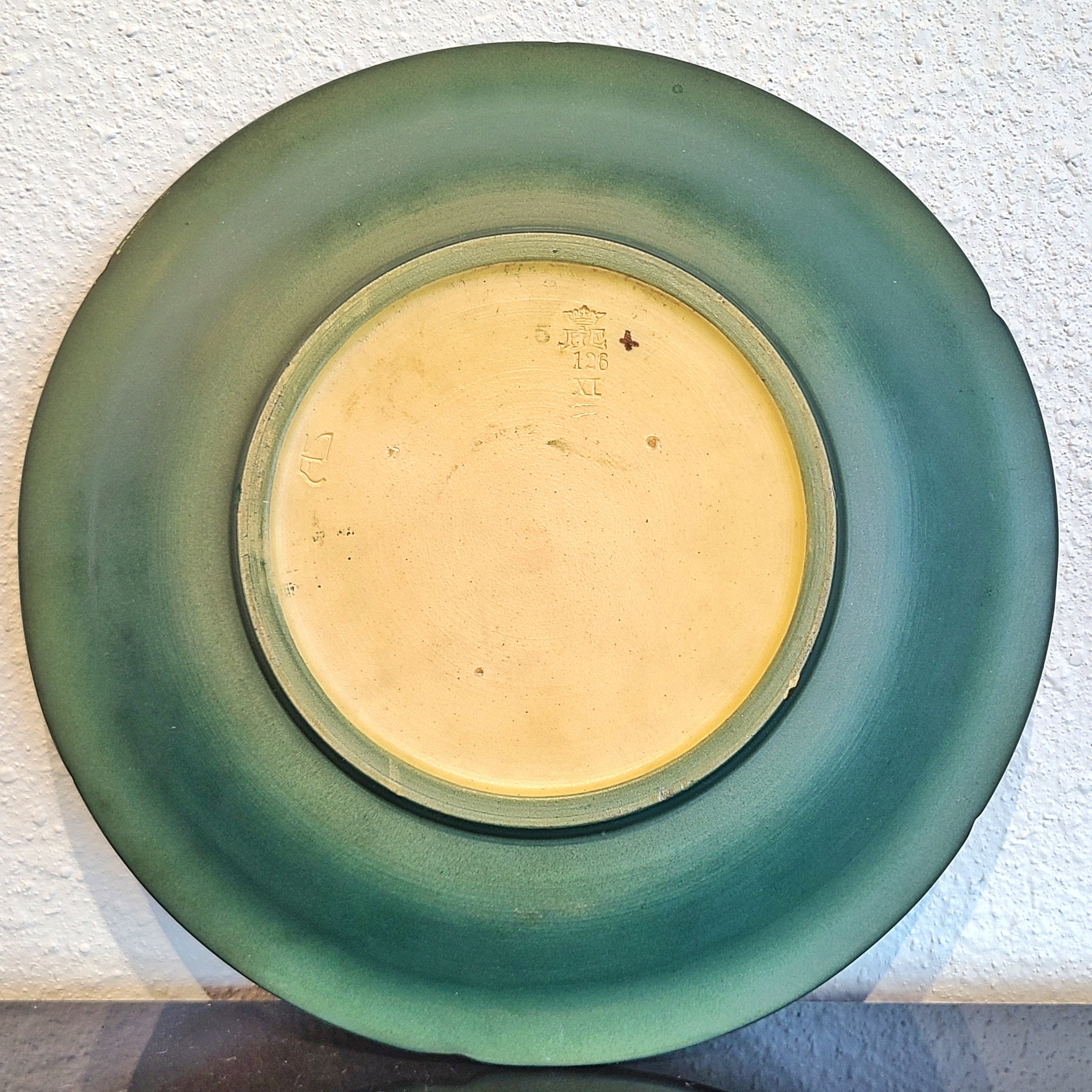








AXEL SØRENSEN ‘THISTLE’ RELIEF DISH FOR P. IPSENS ENKE
CONTACT US HERE ABOUT THIS ITEM.
A decorative stoneware dish with a gorgeous design in high relief of an artichoke and bees designed by Axel Sørensen in 1939 for P. Ipsens Enke (aka P. Ipsen’s Widow), and glazed in Ipsen’s proprietary Dekorativglasur (decorative glaze) developed by Bertel Ipsen around 1910. Early examples of this blended and brightly colored matt glaze were mostly yellow to brownish, but later became a more orangey yellow, graduating into green. This very popular orange and green colorway is found on much of Ipsen’s work during this era. The thistle design has a beautifully textured and detailed high relief typical of much of Ipsen’s output.
AXEL SORENSEN (1891–1967) was a Danish ceramicist who worked for Ipsens Enke from 1923 to 1945. Not much is known about him, except that he was the son of a fisherman. He was an apprentice at Ipsen and became an important influence there. K. Jørgensen and B. Holst (in ‘Et keramisk eventyr’ about Ipsen) list 348 different items assigned to Axel Sørensen.
P. IPSENS ENKE (1843–1955) was established in 1843 by potter Rasmus Peter Ipsen (1815–1860) from Bornholm. When Ipsen was 13 years old, he was sent into service at a brickyard, where he, in his own words, was carrying 4000 bricks every day, which marked him for the rest of his life. Later, he was apprenticed with a joiner who worked him from 5 am to 10 pm, which was so bad for his constitution that he had to quit. In 1833, a school friend found a job for him as a trainee at The Royal Porcelain Factory (later Royal Copenhagen), where he soon became a master thrower with an excellent sense of design and color. His sharp eye for shape made him a favorite of Gustav Friedrich Hetsch. After completing his apprenticeship, Ipsen remained at the Royal Porcelain Factory for six years.
At 28, Ipsen married Louise Christine Ipsen (1822–1905) and established his own pottery on April 15th, 1843, in Nørrebro. His products included hanging flower pots in terracotta, which became the livelihood of the factory, but also pots, lamps, water coolers, and tea sets, as well as replicas of antique Greek amphora vases and vessels painted in oil colors, and figurines, often inspired by the Danish sculptor Bertel Thorvaldsen (1770–1844). At first, he had no oven and had to fire his output at the Royal Porcelain Factory.
Ipsen initially experienced difficulty selling his creations to the city’s many porcelain vendors. Still, demand slowly increased, and by 1847, he could buy a small piece of land and build a new workshop at Frederikssundsvej in Utterslev. He opened a ceramics shop at Bredgade 31 the following year. In 1852, he was represented in an exhibition at Christiansborg Riding Grounds.
Peter Ipsen died early at only 45 years old. His widow Louise Ipsen continued his work, which was unusual in those days, but she had a good knowledge of the factory and had always been a regular visitor there. This was when the factory became known as Ipsens Enke (Ipsen’s Widow). Hermann Bonfils became the company’s manager, and Peter and Louise Ipsen’s son, Bertel Ipsen (1846–1917), became an apprentice under Bonfils in 1861 and became the formal manager of the company when Bonfils was drafted in 1865. Still, his mother continued to play a central role in the operations.
Bertel Ipsen continued in his father’s footsteps with the “Thorvaldsen Style.” He was represented at most world exhibitions and opened shops in Paris and London. Bertel Ipsen developed the blended and brightly colored matt glaze referred to as Dekorativglasur (decorative glaze) around 1910. Initially, it was yellow to brownish, and later, it became a more orangey yellow, graduating into green. The factory experienced a lull in popularity at the end of the 1800s. Still, after receiving a silver medal at the World’s Fair in Paris in 1900, it became hugely popular again, thanks to this glaze, and continues to be famous amongst collectors—although it seems to be better known outside of Denmark. Many later items are decorated with more elaborate patterns, such as animals or birds. Later, Ipsens Enke developed several other interesting glazes, e.g., the so-called Danit glaze.
In 1895, Ipsens Enke was converted into a family-owned limited company and began producing glazed stoneware with more modern designs as the Art Nouveau style exploded on the scene. Many iconic Danish potters and designers started or worked for periods at Ipsen’s, including Axel Salto, Axel Sorensen, Georg Jensen, Just Andersen, Bode Willumsen, Arne Bang, Thorvald Bindesbøll, Christian Joachim Jensen, and Johannes Hedegaard to name a few.
The company was represented at the Nordic exhibitions in Malmö in 1861, Stockholm in 1866, the Exposition Universelle in Paris in 1867, and The Great Exhibition in London in 1870. 1871 P. Ipsens Enke was granted the predicate Purveyor to the Court of Denmark. The company won a gold medal at a competition in Amsterdam in 1877.
Works from Ipsens Enke are represented in the collections of Neue Pinakothek in Munich, the National Museum in Stockholm, the Los Angeles Museum, the Cleveland Museum, the Brooklyn Museum, Carnegie Institute in Pittsburgh, National Museum of Finland in Helsinki, Metropolitan Museum of Art in New York City, Danish Design Museum in Copenhagen, Les Amis des Musees de la ville de Mons in Brussels, National Arts Club in New York City, and the National Museum of Latvia in Riga.
P. Ipsens Enke closed in 1955.
DETAILS
Designer – AXEL SØRENSEN
Design Period/Year – 1930s
Maker – P. IPSENS ENKE
Production Period/Year – 1940s
Origin – DENMARK
Styles/Movements – STYLES
Materials – CERAMIK
Colors – ORANGE & GREEN
Condition – Excellent vintage condition. Minor traces of wear consistent with age and use.
Dimensions – 0 0" W[/DIAM.] × 0 0" D × 0 0" H









